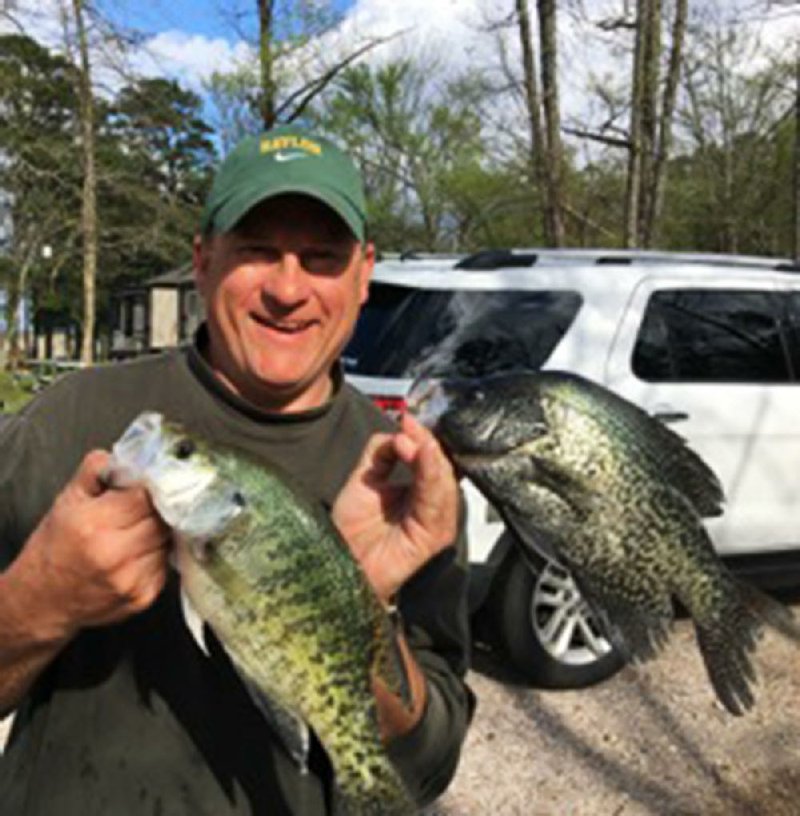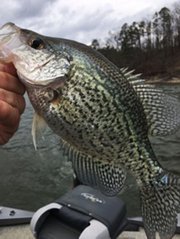Crappie are biting all over the state right now, and this is the easiest time to catch them.
Many Arkansans enjoy crappie fishing with the same fervor with which others enjoy hunting deer, ducks or wild turkeys. Bill Eldridge of Benton loves deer season because it drains most of the fishermen off Lake Ouachita and leaves him and a few other die-hards with some of the year's best crappie fishing to themselves, but crappie fishing in the spring is what they love most.
Eldridge escapes to crappie camp at Lake Ouachita every spring. The fishing is almost always easy because this is when crappie move into shallow water to spawn, but the last couple of weeks it's been easier than ever. That's because the lake has been low, and much of the bankside spawning cover has been high and dry. Crappie are spawning in open water, Eldridge said, and they are easier to reach and more aggressive than usual.
"The funny thing this year is that it's been like bass fishing," Eldridge said. "I'm going up banks casting Tennessee shad Roadrunners and catching crappie that way."
Eldridge said he caught hundreds of crappie in late March and early April, but he's only kept 12-16 inchers, enough to fill the freezer.
"I've got 16 bags of fresh crappie fillets," Eldridge said. "There's probably eight to 10 fish in each bag."
You won't find crappie on every bank, of course, and some are more attractive than others.
"With the brush out of the water, crappie are migrating to really fine gravel spots where the rock is broken up, almost like sandy rock," Eldridge said. "Ouachita has been slowly going up, so that will probably change, but the last three weeks have been pretty consistent because we've had such warm temperatures this year."
Crappie moved shallow earlier than usual this year because of the warm winter, Eldridge said. Spring came a few weeks early and seemed to accelerate the crappie spawning cycle. Eldridge says he can tell they've been shallow for a while because of their deep, rich colors.
All of them have that dark, dark color. Really dark," Eldridge said. "That tells me they've been in the shallows quite a bit."
Eldridge targets crappie in specific topographic features.
"I look for the little cuts where little ridges come together where water runs through little ravines," he said. "Those are usually good hotspots. There's a lot of good organinc material in there, and they're somewhat sheltered form the wind. I also look for banks that get a lot of sunshine in the early part of the day."
With the water slowly rising, the fishing will only get better at Lake Ouachita in the coming days.
"A lot of green vegetation has grown up along the shoreline," Eldridge said. "There's going to be some good cover when the lake comes up and covers those gravelly banks."
Mark Hedrick of Little Rock is well known for catching crappie in deep structure at Lake Maumelle in the summer and fall, but like Eldridge, he catches them off the banks in the spring.
"I'm going to use a 1/16- or 1/32- ounce jighead," Hedricks said. "I'll put it on light line, either 4-pound mono(filament) or 6-pound flouro(carbon), and I would start out paralleling the grasslines and swim that jig out."
Crappie will hit a jig coming out of grass as a defensive reaction, Hedrick said. It's not a feeding reaction, but it is important for the lure to be lively. For that reason he uses a small, soft-plastic twistertail or something like a Bobby Garland minnow.
"I'm using white/chartreuse, red/chartreuse and black/chartreuse," Hedricks said. "I'm just trying to mimic a little something that they may think is going eat their babies. A lot of times they just react to something coming out of the grass real quick."
At Lake Maumelle, Hedrick said he begins the season in the west end where there are rocks and stained water. The west end is also shallow, so it warms quicker than the middle and east sections.
"I'll start at the warmest end of the lake and work down, like clockwork," Hedrick said. "I'll follow that lake around the north side and come back up the south side."
Depending on the depth of the grass, there are a lot of ways to fish grass, Hedrick said. If grass is in deep water, he might use a bubble cork to suspend a jig.
"If grass is 8 feet deep, I'll put [a] jig under a cork at 6 feet and hover it over the grass," Hedrick said. "I'll twitch it and kill it, twitch it and kill it. A lot of times they'll come up and wear it out. That's a fun way to fish."
Spider rigging has largely replaced corking, Hedrick said. Spider rigging is a method of slow trolling several lines over deep cover at different depths. It allows you to determine the depth at which fish are most aggressive and zero in on them more quickly.
"It's the same approach," Hedrick said.
In lakes with shallow cover, like Lake Conway, you can dap jigs or minnows around stumps and laydown logs with a long crappie pole. If a crappie is present, it will usually bite.
"I use a 12- to 14-foot pole with a long leader with a tube jig or twister tail," Hedrick said. "Dip it around stumps, trees and buckbrush, and you can jerk them out of there doing that."
Popular colors in the spring for this kind of fishing are "electric chicken" and "barbecue chicken."
The knot is an important part of the presentation. Use a loop knot for suspending presentations, "If you're tight lining, tie a loop knot so the jig is level," Hedrick said. "If it's just laying there and the head of the jig is pointing down, it doesn't look natural. It doesn't matter if it's swimming."
Surprisingly, you can also catch crappie in creeks and rivers this time of year. One of my favorite techniques when floating the Saline and Ouachita rivers is to tightline white, chartreuse or yellow marabou jigs around fallen treetops and the ends of submerged logs with the same tackle that Hedrick uses for tightlining.
You have to be careful, though, because white bass are in the creeks and rivers right now. You can jerk a crappie up with 4-pound line, but a white bass will break your line.
It doesn't matter though, because it's all fun, and it's happening now.
Sports on 04/09/2017

